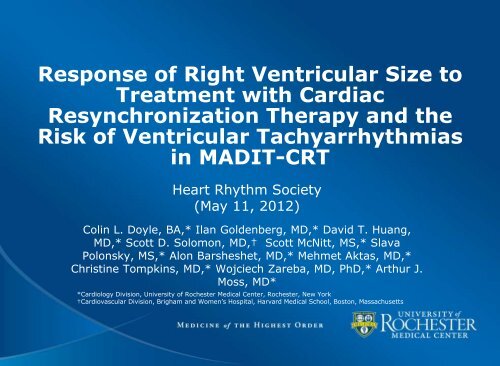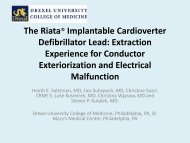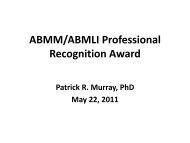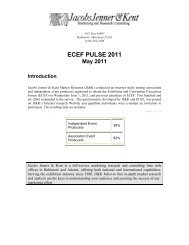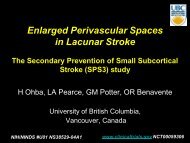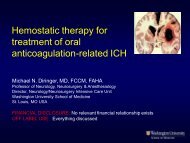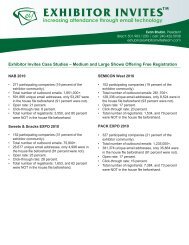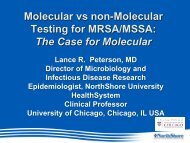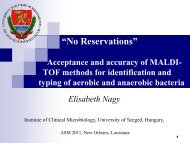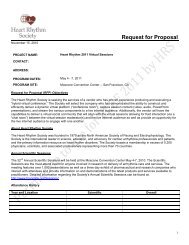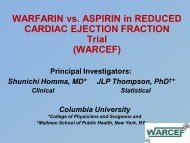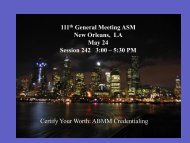Response of Right Ventricular Size to Treatment with Cardiac ...
Response of Right Ventricular Size to Treatment with Cardiac ...
Response of Right Ventricular Size to Treatment with Cardiac ...
Create successful ePaper yourself
Turn your PDF publications into a flip-book with our unique Google optimized e-Paper software.
<strong>Response</strong> <strong>of</strong> <strong>Right</strong> <strong>Ventricular</strong> <strong>Size</strong> <strong>to</strong><br />
<strong>Treatment</strong> <strong>with</strong> <strong>Cardiac</strong><br />
Resynchronization Therapy and the<br />
Risk <strong>of</strong> <strong>Ventricular</strong> Tachyarrhythmias<br />
in MADIT-CRT<br />
Heart Rhythm Society<br />
(May 11, 2012)<br />
Colin L. Doyle, BA,* Ilan Goldenberg, MD,* David T. Huang,<br />
MD,* Scott D. Solomon, MD,† Scott McNitt, MS,* Slava<br />
Polonsky, MS,* Alon Barsheshet, MD,* Mehmet Aktas, MD,*<br />
Christine Tompkins, MD,* Wojciech Zareba, MD, PhD,* Arthur J.<br />
Moss, MD*<br />
*Cardiology Division, University <strong>of</strong> Rochester Medical Center, Rochester, New York<br />
†Cardiovascular Division, Brigham and Women’s Hospital, Harvard Medical School, Bos<strong>to</strong>n, Massachusetts
Background<br />
• Sudden cardiac death 1/3 or more <strong>of</strong> deaths in heart<br />
failure<br />
• Majority from ventricular tachycardia/fibrillation<br />
(Shiga and Kasanuki. 2007)<br />
• <strong>Cardiac</strong> resynchronization therapy (CRT) can<br />
decrease risk <strong>of</strong> ventricular arrhythmias (VA) (Higgins, et al.<br />
2000, Arya, et al. 2005, Kies, et al. 2004, Di Biase, et al. 2008)<br />
• Possibly due <strong>to</strong> remodeling: focus on left ventricle<br />
(LV) (Solomon, et al. 2010, Barsheshet, et al. 2011)<br />
• Severe right ventricular (RV) dysfunction in low LVEF<br />
predicted ICD shocks or death (Aktas, et al. 2009)
Study Questions<br />
• Relationship between RV size and VA<br />
• Relationship between RV size and CRT response<br />
• Risk reduction <strong>with</strong> RV remodeling<br />
3
• MADIT-CRT (Moss, et al. 2005)<br />
Methods<br />
• 1820 patients at 110 sites in North America and Europe<br />
over 4.5 years<br />
• Ischemic and non-ischemic cardiomyopathy<br />
• LVEF 130 msec<br />
• NYHA class I or II<br />
• 3:2 randomization for CRT-D or ICD<br />
• Echocardiograms (according <strong>to</strong> ASE, Lang, et at. 2005)<br />
• Prior <strong>to</strong> device implantation (n = 1809)<br />
• At one year (n = 626 in ICD group; n = 752 in CRT-D<br />
group)<br />
• Paired studies in 1372 patients<br />
4
Methods (cont.)<br />
• Group Categorization<br />
• RV size RVEDA/BSA<br />
• Baseline RVEDA/BSA first quartile 1 st quartile<br />
change (>3% reduction)<br />
• Primary endpoints: 1 st VT/VF or death and 1 st<br />
VT/VF or death after 1 year<br />
5
Baseline Patient Characteristics<br />
RVEDA/BSA 13<br />
cm2 /m2 Age 61.7±10.5 65.6±10.6<br />
Female sex 14% 29%<br />
LBBB 65% 72%<br />
LVEF 30.0±3.4 28.8±3.4<br />
Diabetes 38% 28%<br />
Hypertension 69% 61%<br />
BMI 32.4±5.4 27.5±4.7<br />
*All p-values < 0.005<br />
6
Cumulative probability <strong>of</strong> VA by baseline<br />
RVEDA/BSA in ICD-only patients<br />
7
Cumulative probability <strong>of</strong> VA or death by<br />
treatment in patients <strong>with</strong> greater RVEDA<br />
(Q2-4)<br />
8
Cumulative probability <strong>of</strong> VA or death by<br />
treatment in patients <strong>with</strong> smaller RVEDA<br />
(Q1)<br />
9
Multivariate analysis: CRT-D vs. ICD-only risk<br />
<strong>of</strong> VT/VF or death by baseline right<br />
ventricular size<br />
BASELINE RV SIZE (RVEDA/BSA) HR 95% CI P Value<br />
Q2-Q4 (n=1121) 0.73 0.59-0.90 0.003<br />
Q1 (n=374)<br />
1.00 0.68-1.48 0.998<br />
*All findings are adjusted for left ventricular end dias<strong>to</strong>lic volume adjusted for body surface<br />
area, left ventricular ejection fraction, left bundle branch block, female sex, QRS, his<strong>to</strong>ry <strong>of</strong><br />
ventricular arrhythmias, and current smoking status<br />
10
Relationship between RV response <strong>to</strong> CRT-D<br />
and Outcome<br />
11
Multivariate analysis: Risk <strong>of</strong><br />
subsequent VA according <strong>to</strong> RV<br />
response<br />
Percent change in RVEDA after 1 year HR 95% CI P Value<br />
CRT-D: >1 st quartile RVEDA response vs. ICD-only<br />
0.55 0.41-0.74
Conclusions<br />
• Patients <strong>with</strong> larger right ventricles at baseline have<br />
greater risk <strong>of</strong> VA<br />
• CRT-D therapy reduces risk <strong>of</strong> VT/VF or death in patients<br />
<strong>with</strong> enlarged right ventricles<br />
• In patients who achieve RV remodeling from CRT-D<br />
therapy, subsequent risk for VT/VF or death is reduced<br />
• Quantification <strong>of</strong> the RV may be useful in determining<br />
who will benefit from CRT-D therapy<br />
13
Acknowledgements<br />
• Arthur J. Moss, MD<br />
• Ilan Goldenberg, MD<br />
• David T. Huang, MD<br />
• Scott D. Solomon, MD<br />
• Scott McNitt, MS<br />
• Slava Polonsky, MS<br />
• Mehmet Aktas, MD<br />
• Alon Barsheshet, MD<br />
• Christine Tompkins, MD<br />
• Wojciech Zareba, MD, PhD<br />
14
References<br />
• Shiga, T and Kasanuki, H: Drug therapy for ventricular tachyarrhythmia in heart failure. Circulation journal : <strong>of</strong>ficial journal <strong>of</strong> the<br />
Japanese Circulation Society 2007; 71 Suppl A:A90-6.<br />
• Higgins, SL, Yong, P, Sheck, D, et al: Biventricular pacing diminishes the need for implantable cardioverter defibrilla<strong>to</strong>r therapy.<br />
Ventak CHF Investiga<strong>to</strong>rs. Journal <strong>of</strong> the American College <strong>of</strong> Cardiology 2000; 36:824-827.<br />
• Arya, A, Haghjoo, M, Dehghani, MR, et al: Effect <strong>of</strong> cardiac resynchronization therapy on the incidence <strong>of</strong> ventricular arrhythmias in<br />
patients <strong>with</strong> an implantable cardioverter-defibrilla<strong>to</strong>r. Heart rhythm : the <strong>of</strong>ficial journal <strong>of</strong> the Heart Rhythm Society 2005; 2:1094-<br />
1098.<br />
• Kies, P, Bax, JJ, Molhoek, SG, et al: Effect <strong>of</strong> left ventricular remodeling after cardiac resynchronization therapy on frequency <strong>of</strong><br />
ventricular arrhythmias. The American Journal <strong>of</strong> Cardiology 2004; 94:130-132.<br />
• Di Biase, L, Gasparini, M, Lunati, M, et al: Antiarrhythmic effect <strong>of</strong> reverse ventricular remodeling induced by cardiac<br />
resynchronization therapy: the InSync ICD (Implantable Cardioverter-Defibrilla<strong>to</strong>r) Italian Registry. Journal <strong>of</strong> the American College<br />
<strong>of</strong> Cardiology 2008; 52:1442-1449.<br />
• Solomon, SD, Foster, E, Bourgoun, M, et al: Effect <strong>of</strong> cardiac resynchronization therapy on reverse remodeling and relation <strong>to</strong><br />
outcome: multicenter au<strong>to</strong>matic defibrilla<strong>to</strong>r implantation trial: cardiac resynchronization therapy. Circulation 2010; 122:985-992.<br />
• Barsheshet, A, Wang, PJ, Moss, AJ, et al: Reverse Remodeling and the Risk <strong>of</strong> <strong>Ventricular</strong> Tachyarrhythmias in the MADIT-CRT<br />
(Multicenter Au<strong>to</strong>matic Defibrilla<strong>to</strong>r Implantation Trial-<strong>Cardiac</strong> Resynchronization Therapy). Journal <strong>of</strong> the American College <strong>of</strong><br />
Cardiology 2011; 57:2416-2423.<br />
• Aktas, MK, Kim, DD, McNitt, S, et al: <strong>Right</strong> ventricular dysfunction and the incidence <strong>of</strong> implantable cardioverter-defibrilla<strong>to</strong>r<br />
therapies. Pacing and clinical electrophysiology : PACE 2009; 32:1501-1508.<br />
• Moss, AJ, Brown, MW, Cannom, DS, et al: Multicenter au<strong>to</strong>matic defibrilla<strong>to</strong>r implantation trial-cardiac resynchronization therapy<br />
(MADIT-CRT): design and clinical pro<strong>to</strong>col. Annals <strong>of</strong> Noninvasive Electrocardiology : The Official Journal <strong>of</strong> the International Society<br />
for Holter and Noninvasive Electrocardiology, Inc 2005; 10:34-43.<br />
• Lang, RM, Bierig, M, Devereux, RB, et al: Recommendations for chamber quantification: a report from the American Society <strong>of</strong><br />
Echocardiography's Guidelines and Standards Committee and the Chamber Quantification Writing Group, developed in conjunction<br />
<strong>with</strong> the European Association <strong>of</strong> Echocardiography, a branch <strong>of</strong> the European Society <strong>of</strong> Cardiology. Journal <strong>of</strong> the American Society<br />
<strong>of</strong> Echocardiography : <strong>of</strong>ficial publication <strong>of</strong> the American Society <strong>of</strong> Echocardiography 2005; 18:1440-1463.<br />
15
Disclosures<br />
• The MADIT-CRT study was supported by a research grant from Bos<strong>to</strong>n<br />
Scientific, St. Paul, Minnesota, <strong>to</strong> the University <strong>of</strong> Rochester School <strong>of</strong><br />
Medicine and Dentistry<br />
• David T. Huang, MD receives research grants from Bos<strong>to</strong>n Scientific,<br />
St. Jude Medical, Medtronic and Biotronik and fellowship support from<br />
St. Jude Medical, Bos<strong>to</strong>n Scientific and Medtronic<br />
• Scott D. Solomon, MD has received a research grant from Bos<strong>to</strong>n<br />
Scientific<br />
• Wojciech Zareba, MD, PhD receives a research grant from Bos<strong>to</strong>n<br />
Scientific<br />
• Arthur J. Moss, MD receives a research grant from Bos<strong>to</strong>n Scientific<br />
• The other authors have no relationships <strong>to</strong> disclose<br />
16


